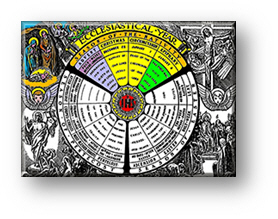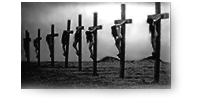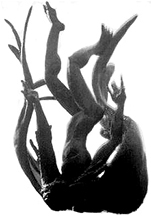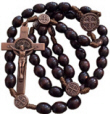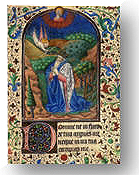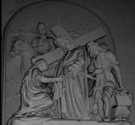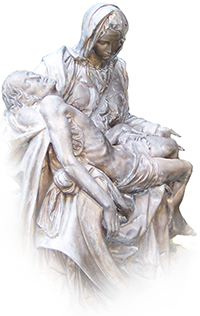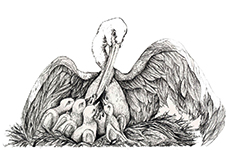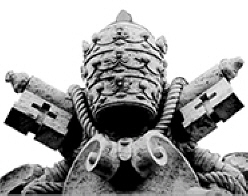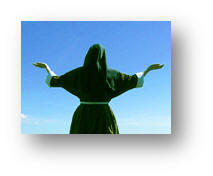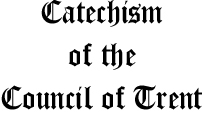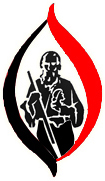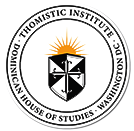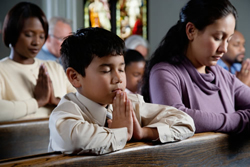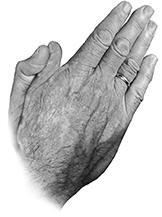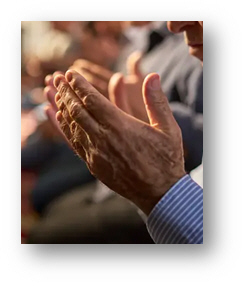|
How should we Hold
our Hands at Mass?
|
|
We must always bear in mind Christ’s admonition: “When you pray, you shall not be as the hypocrites, that love to stand and pray in the synagogues and corners of the streets, that they may be seen by men.” (St. Matthew 6.5)
This confusion did not exist prior to much of the even greater confusion engendered by corrupt “interpretations” of the Second Vatican Council and that ever-elusive “spirit of the Council” that often egregiously flies in the face of genuine Catholic theology, doctrine and dogma. If anything was absolutely certain it was equally absolutely tentative. Hence the confusion that still has us scratching our heads sixty years later, terribly unsure about what authentically constitutes a Catholic in light of this overwhelming and often illogical exegesis. Even the simplest things have become cause of contention, doubt, and uncertainty.
Like a man doubting his own identity and reaching out to others who do not know him to confirm it — the “Second Vatican Council” reached out in the broadest “inclusive” terms, to strangers who did not know the Church ... and even detested it, to reassure them that after Vatican II the Church was no longer what it had always claimed to be, but now — finally enlightened after 2000 years of misunderstanding itself — and having been corrected by Vatican II, is now what it ought to have been. This, despite the 1,981 years of constant teaching between Pope Linus, 67 A.D. — the next pope after St. Peter himself — and Pope Pius XII in 1958. That is to say, after almost 2000 years ...
“Do you, yourselves, not know who you are?” Protestants asked incredulously. “Are you not certain? Then surely we will tell you.
Now that you are enlightened, you are becoming us, whose revolt against you, you have finally accepted and endorsed. We are ... all of us ... since Vatican II leveled the playing field ... the all-inclusive “People of God” — despite differences and contradictions in doctrine, dogma, and even our religions themselves!”
This was the clarion, the evangel, that became the “Spirit of Vatican II”. No one left out in cold — no matter what Christ said about no one coming to the Father except through Him (St. John 14.6).
Our prayers became the prayers of others (“for Thine is the Kingdom and the power ...” a gloss uttered only by Protestants prior to Vatican II); and we even greeted one another, and our own priests greeted us, in Yiddish, with “Shalom!.” We sang their songs, who did not sing ours ... Martin Luther but not Saint Gregory. We prayed their vernacular who did not pray in our Latin. We stripped our churches in an ecumenical impulse to shared sterility. We de-canonized our saints while adulating their “Reformers”. They gained Paradise, one and all, and we lost Hell. They attained to effortless and egalitarian sanctity while we relinquished the notion of sin. It is odd. We became like unto them who disdained to become like to us — who have become like to them!
All things uniquely Catholic were deconstructed, de-emphasized, demoted, demolished or abolished. Entire devotions and Solidarities vanished as inimical to “ecumenism.” Confessionals disappeared or became therapy rooms (by appointment). Our priests faced the people like our formerly “separated brethren”, and turned their backs to God. The “People of God” metamorphosed into God Himself — to whom was lifted the Sacrifice and Oblation that had anciently been lifted up to God!
Is it really any wonder that we have even forgotten how to pray as Catholics? It is this, and not all the incalculable devastation wrought by the “spirit of Vatican II” that we wish to address now. Perhaps it is this collective amnesia that has become the last vestige of a unique and once universal culture that we called Catholicism. Something simple and utterly Catholic — in how we pray as Catholics.
Praying 101
How do Catholics pray? It is a modest and simple beginning to recovering what was lost. Something small and apprehensible, like a mustard seed. The Teaching Sisters taught us that we held our hands in the form of a steeple, palms pressed together, fingers pointed up to God, and the right thumb over the left forming a Cross (We were also taught, incidentally, to bow our heads at the Sacred Name of Jesus — always and everywhere, without exception — but this, too, quickly disappeared after 1962 ... Saint Paul notwithstanding.1 ) It is simple enough a question, unlike seeking comprehensible reasons for now having:
-
Three different “Forms of Greeting” in the Novus Ordo Mass — from 1 in the Latin Mass of 2000 years
-
Three different “Forms of the Penitential Act” in the Novus Ordo Mass — from 1 in the Latin Mass of 2000 years
-
Ten different “Eucharistic Prayers” in the Novus Ordo Mass — from 1 in the Latin Mass of 2000 years
-
Four “Forms of Dismissal” (when they are not improvised) — in the Novus Ordo Mass from 1 in the Latin Mass of 2000 years
Out of breath, yet?
No one wishes to be conspicuous, or to presume to set themselves
apart from others in a way that would invite their being deemed
affectatious or hypocritically holy. Since the emphasis on minimizing
ritual at large (when was the last time you knelt, let alone
bowed as indicated in the missal upon reciting the words in the
Nicene Creed “And the Word was made flesh
and dwelt among us” since the Novus Ordo of the Second
Vatican Council? We have never once — repeat, not once — observed
this in any Novus Ordo Mass anywhere in the world, even while
the missal explicitly directs both priest and congregation
to bow upon enunciating these words.
Since this repudiation of ritual at large, a dichotomy — a kind of sundering of sorts — has resulted between posture and intention, a disjunction between the body and the soul. We refuse — or fear — to allow our body to conform to our soul: what our bodies display and signify is not in accord with what is in our hearts; we are divided within ourselves; our minds, our hearts, pray, say, fervently believe, one thing — but in our bodies there is nothing indicative of it, nothing in union with, expressive of, what is in our minds. As it were, our minds worship, bend before the will of God ... but our bodies do not? “That is my own affair”, you say. “What I pray and how fervently I believe is my business alone; it is between God and me.”
This is true. That is to say, it is true of private prayer — but not of public worship, in which we act as one body and in which our unity with our neighbor as members of the one Body in Christ is signified, enacted, through a common ritual that is a collective statement of otherwise utterly unique parts in that One Body. What we express with our bodies, our postures, our verbal prayers, is a communion in that One Body that we cannot express, attain to, through our individual and private prayers.
There is a difference between how we pray privately and publicly. We do not bring our own private idiosyncrasies to Mass. We worship, pray, not simply as ourselves, but as members the Communion of Saints (you will pardon me if I defer from using the much abused trope “People of God”), as a spiritual body larger than our own physical bodies. We pray as a Church, together, united in one belief, one creed, commonly, and such common worship can only be coherently united through ritual, through a shared ritual that expresses the unity of our belief. Through the active participation in ritual we become visibly one; before God and to each other! Do you not see it?
Rituals are Enacted by Bodies
At our homes, behind
closed doors, we can and should pray as God inspires us and teaches
us. The ways are myriad. But at the Most Holy Sacrifice of the Mass
we pray not only with our individual assent and fervor, but as a
body of believers greater than the particular bodies that our individual
souls inhabit. What unites this mass of individuals with different
aspirations but the same object of worship? Ritual. What
we do in common; what is a visible, almost sacramental reality,
our collective affirmation of what we believe though the common
form of shared ritual. Rituals are enacted by bodies, not
minds, even as they are a visible manifestation of the invisible
mind. Rituals present shared, that is to say, commonly (as “in common”)
accepted realities to the mind through the bodies of others, specifically
through the visible acts of the bodies of others.
So, what to do about those awkward hands that appear so vexsome
during Mass? Where do we put them? The Caeremoniale Episcoporum
(1985) in the paragraph De manibus iunctis
is clear about the Catholic posture concerning the folding of
the hands during Mass and prayer:
“When it says with hands folded, it is to be understood in this way: palms extended and joined together in front of the breast, with the right thumb over the left in the form of a cross” (#107, n.80)”
Another form, long in tradition, and also reverent while standing (pressed gently against the waist), as well as in kneeling, is hands clasped in prayer with thumbs forming a Cross ... although we hasten to add that this form is not uniquely Catholic:
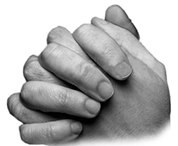
Now, as to whether
it really matters or not. Surely God hears our earnest prayers no
matter how we fold our hands in prayer, or even if we fold them
at all. However, we do know that people who do not know God or love
Him do not do this. I personally have never observed an atheist,
skeptic, or agnostic pray at all. I have no evidence of it. There
is nothing in either their posture or their words to convey to me
not just an attitude of prayer, but the actuality of prayer. In
a word, there are gestures and postures, that we assume as Catholics
that others do not. They are signs distinctly, uniquely — and historically
— associated with Catholics. It is what Catholics do. It is part
of our identity of being a Catholic. We have Crucifixes with the
Corpus Figure of Christ on them, rather than plain Crosses.
We have Rosaries. Up to 40 years ago we bowed our heads whenever
the Sacred Name of Jesus was uttered. We struck our breasts in reciting
the Confiteor, made the Sign of the Cross before we went into the
water or upon any undertaking. These things do not necessarily identify
us as Catholics, but they are unmistakably signs of Catholics.
What is more, because we are Catholics we do, in fact —or ought
to — behave differently at Mass than we do at home, or in a pub.
We do not (or ought not) cross our legs, lean back over the pew
behind us, or wear gym suits or baseball hats. Reverence precludes
this. Or are we lacking in due reverence to God and Church? Our
voices are decidedly more subdued at the local bank, and our actions
much more restrained than they typically are in Novus Ordo
Churches. I urge you to go to a Tridentine (Latin) Mass to experience
the stunning difference. And yet, oddly enough, the problem of those
vexingly awkward hands persists in both. Why?
Disdain for Ritual
It is likely that the
ritual and custom has been forgotten altogether in the passing of
two generations alone. We see the proper posture of prayer illustrated
in all our religious statues (those that still remain) and sacred
art. But somehow we are obtuse to the inspiration that such statuary
and art is intended to invoke. We have somehow come to believe that
such postures of prayer are, in fact, factitious, strained, unreal
— that the people — of whom the statues are likenesses only — prayed
differently than portrayed by the artist or sculptor. Perhaps only
Saints prayed that way. But are we not all called to emulate the
saints? Why are we so afraid of the odor of sanctity? Is there anything
more beautiful than a Catholic conformed to Christ, to the Saints
who were conformed to Christ? We fear being seen as Pharisees, hypocrites.
Are there some? Yes, some. Are there Catholics possessed of sanctity
conferred upon them by God? Yes, some. Perhaps many. But we are
so afraid of the judgment of the world (which should mean nothing
to us)! Even of the judgment of our own brothers and sisters in
Christ. Rather than being pleasing in the sight of God and Holy
Church, we would please men?! Saint Paul is absolutely clear about
this: “For do I now persuade men, or God?
Or do I seek to please men? If I yet pleased men, I should not be
the servant of Christ.” 2
What, then, should be our posture of prayer
at Mass — and is it really important?
While standing we see
hands hanging limply, stuffed into pockets, clasped behind backs,
leaning, palms down, upon the back of the next pew. While sitting
they are stretched out on the pew behind them in a grand and expansive
gesture of detached (and irreverent) relaxation, or caressing and
massaging the backs or necks of their spouses, girlfriends or boyfriends,
folded across their chests as if in deliberation or impatience,
or as objects of sudden and peculiar interest to them as they almost
clinically examine their cuticles and fingernails. While kneeling,
the uncertainty of what to do with their hands is particularly acute
and most obvious. They are either limply hung over the backrest
of the pew in front of them, unjoined, crossed at the wrists as
if relaxed, or loosely clasped in a manner reminiscent of piety,
but diligently casual enough not to openly express it.
Going to Holy Communion they are at one’s sides, behind one’s back,
swinging in a natural gait, and, of course, casually folded, usually
to the maximum extent allowed by the length of one’s arms. Are we
embarrassed to hold our hands properly in prayer? Are we afraid
to be thought sanctimonious, putting our devotion on display? We
all kneel the same way: on our knees. Why cannot we hold our hands
the same way — expressing unity in all things in worship,
instead of the strident cry for diversity in all things?
Look at our children at their First Holy Communion. See how their
hands are folded as an example to us! Is that our way, then?
Teach our children one thing, and do another? Do only statues, following
our First Holy Communion, give us this example? And what is the
value of a statue if it does not inspire us and call us to emulate
Mary and the Saints? Do you not know that you are called to be a
saint, too?
Diversity engenders division!
Do not be your “own individual” at Mass. The Mass is not about “you” — it is about Christ — and also about unity through Him, with Him, and in Him! “Ut unum sint” … Christ prayed, “That they may be one”.3 Have we not had enough of “diversity” at Mass, and for far too long? Diversity engenders division! The very etymology of the word derives from the Latin diversitatem, or “contrariety, contradiction, disagreement”. “Diversity” has been the unrelenting mantra of the “spirit” of the Second Vatican Council ... as it has been implemented — and to what grievous an aftermath! The “unity” so sought after became “diversity” and diversity became division in every parish. No?
There IS Beauty in Uniformity
Contrary to the prevailing mind-set, there is beauty in oneness in purpose and expression. Can you imagine a stadium filled with people, each singing their own version of the National Anthem — and each a different tune? What is Dvorak’s New World Symphony if every symphony orchestra played it, not according to the composer’s notation, but to their own improvised notation? Whatever cacophony it becomes, it does not remain, and will not be recognized, as the New World Symphony composed by Dvorak. There is beauty, clarity, and united purpose in harmony, in union, in oneness — when everyone is on the same page and not on a page of their own choosing. Do you not see this?
The Japanese use an
aphorism that is particularly apropos of this discussion: “The
nail that sticks out gets hammered down.” What is incongruous
and not in harmony is discouraged. The trumpet player who plays
too loudly when his part is to be subdued, is corrected. The cellist
who spontaneously enters into a rhapsodic frenzy independent of
the composition and notation — ignoring the conductor — is scolded.
The desire to “stick out”, to “be observed”, to call attention to
oneself by not comporting oneself in harmony with all those around,
is nothing less than vanity and self-aggrandizement.
The absence of folded hands in prayer (and especially going to Holy
Communion — which, of course, the entire congregation does since
none are sinners any longer, or at least after Vatican II) is the
absence of reverence before the holy. Would you so insolently stride
up to Christ Himself (which you do) with hands carelessly hanging
like limp appendages at your sides, or stuffed into your pockets?
This speaks much about your faith — or lack of it. We would not
so casually greet a president or prime minister. Why? It would be
presumptuous and insolent —and you know it! But our Blessed Lord
...?
The Speed-Blessing
While we are at it,
and as an aside, but not without relevance, when you bless yourself,
realize in Whose Name you bless yourself: The Name of the Father,
and of the Son, and of the Holy Ghost. In the name of God Himself!
Why do you make the Sign of the Cross so hastily and often so sloppily?
Think of what you are doing! Of Whom you are invoking! Priests are
often as guilty of this as laymen. The SIGN OF THE CROSS (before
which the devil flees and under which Constantine conquered) you
do as if it had no meaning, no significance. The Sign of the
Cross should be made slowly, reverently, purposefully, thoughtfully
— in recognition of Him Who in that act anoints you! Why the
speed-blessing? Is the Name of God, the Sign of the Cross through
which you have been purchased and redeemed at so incalculable a
cost … so trite? One observer of Saint Bernadette was deeply struck
by the way she made the Sign of the Cross while praying before Mary
at Lourdes. It was slow, each name uttered with love, and totally,
surpassingly, reverent! Should our signing ourselves with the Cross
be less reverent?
Not just what you pray, but how you pray, will be a witness
to the reality of God to others, not because you wish it to be,
but simply because it is so. In this sense you yourself, unknowingly,
become something of a sacramental.
Other Forms of Holding one’s Hands in Prayer
Given what we have just said, it is nevertheless the case that some people (since Vatican II) choose to hold their hands in prayer in an idiosyncratic expression of their own personal and peculiar iteration. Let us look at two physical attitudes of prayer that we are likely to encounter at the Novus Ordo Mass:
-
The Orans (literally, “praying” in Latin) posture. Here the supplicant holds one hands extended upward in imitation of the priest at the Altar who does this according to the rubrics in his Sacramental and priestly faculty in representing the congregation. This has largely, and illegitimately, come into practice through so-called “Charismatic Catholics”, or the “Charismatic Renewal” (yet another faction and another “renewal” in the Church, and which provides “workshops” for learning glossolalia, or “speaking in tongues” — the not-so-spontaneous (because it is taught, studied, learned, and practiced in these “workshops”) uttering of verbal nonsense — indecipherable even to other “Charistmatics”, but presumably understandable by God before Whom they hold themselves to spontaneously aspire ... in what has in fact been taught, studied, learned, and practiced!).
It is noteworthy that concelebrants of the Mass (other priests) and deacons refrain — in compliance with the rubrics of the Mass — from using the orans posture; only the main celebrant is instructed to do so who, once again, in himself represents all those present at the Mass. This quasi-priestly orans gesture is yet another instance of the increasing permeability between the Sanctuary and the pews: we commonly see this when the priest illicitly leaves the Sanctuary to be democratically immersed in the pews as just “one of the guys” rather than an alter Christus set apart, and the laity (mostly women) swarm the Sanctuary in every “Ministry” (hence having “Ministers”) fabricated since Vatican II. Prior to Vatican II Catholics had Priests and Protestant had Ministers. We now have both, and many more “Ministers” than Priests.
Is the orans posture uniquely Catholic? No! Until the “Charismatic Renewal” that renewed nothing, it was confined to emotionally-imbued Protestant revivalist meetings, American Pentecostalists, and Evangelicals. Yes, there are some ancient Catholic murals depicting people praying in the orans posture — just as it is found in pre-Christian pagan illustrations and engravings in Egypt and Mesopotamia. In a word there is nothing at all distinctively Catholic in this posture of prayer. Is it bad? No. No form of genuine prayer is bad. Is it liturgically correct? No. It is the proverbial “Deru kugi wa utareru”, the nail sticking up calling for attention (St. Matthew 6.5), when our attention should be directed to God Alone in the Most Holy Sacrifice of the Mass. -
Hands Cupped. We are uncertain of the origin of this posture of prayer which most likely derives from the Muslim tradition of the 19th Rakat of the Salat in private prayer: “Say prayers with hands cupped and palms up at chest level.” 4 There is no precedent in Catholicism — or Christianity — for holding ones hands in this manner during prayer. Presumably it is an attitude of receptiveness to God's blessings as a cup receives water. This is a charitable interpretation. According to AllExperts, in Buddhism, “hands are a little cupped rather than strictly palm-to-palm, because they are supposed to represent a lotus bud — that pure, beautiful flower that grows up out of the mud!” 5 Once again, there is not only nothing distinctly Catholic in this attitude of prayer, apart from the idiosyncrasy of the one praying, but no apparent association with Christianity at all. Once again it is “Deru kugi wa utareru.”
Ut unum sint! “That they may be one.” Such a beautiful — and since Vatican II — elusive desideration!
__________________________
1
Philippians 2:10
2 Gal. 1.10
3 St. John 17:21
4 https://sufism.org/foundations/salaat/salaat-2
/ https://unsplash.com/s/photos/muslim-prayer
5
https://en.allexperts.com/q/Buddhists-948/2008/4/Prayer-Hands.htm
Editor
Boston Catholic Journal
|
Totally Faithful to the Sacred Deposit of
Faith entrusted to the Holy See in Rome
|

